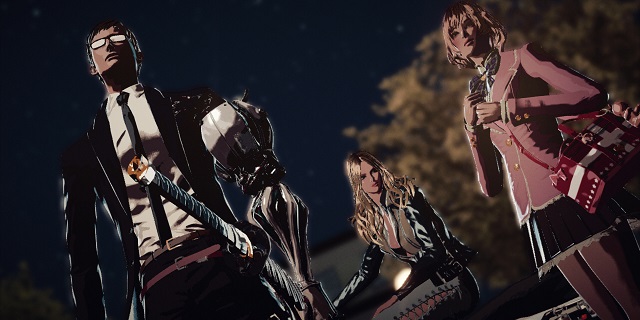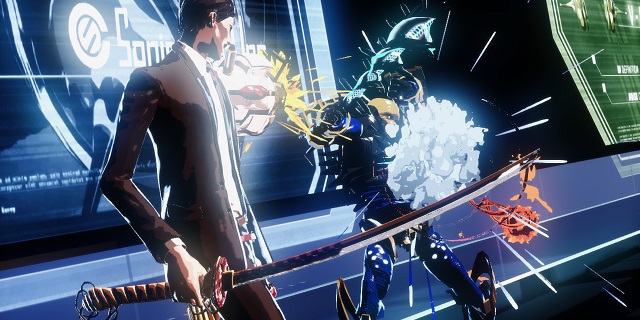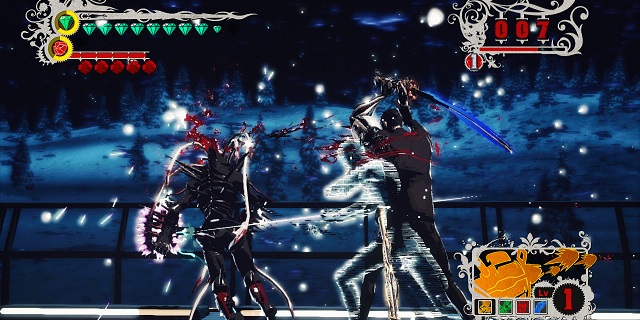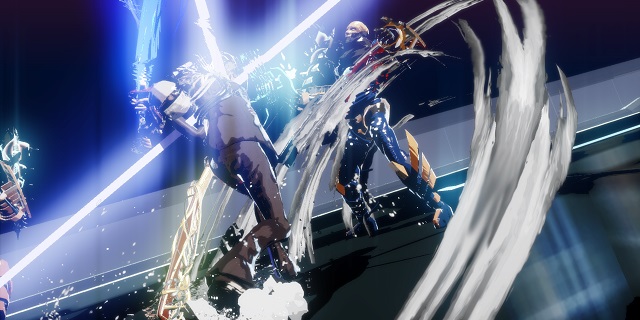
Before even starting Killer is Dead, the splash screen displays an illustration of protagonist Mondo Zappa shrouded in shadow, holding the sharp side of his sword up to a woman’s neck. Her eyes are rolled back in ecstasy; she finds pleasure in being preyed upon. This image exemplifies the tone of Killer is Dead: it is dark, violent and sexual, more often together than separate.
Over-the-top sexuality and violence isn’t unfamiliar territory for auteur game designer Goichi Suda (Suda 51). His works are largely inspired by ’70s grindhouse cinema, and are often filled to the brim with ironic crassness. No More Heroes, the game’s clear mechanical predecessor, was a comedic examination of sociopathic behavior revolving around the consumption of pop culture. Killer is Dead is a drastic tonal shift in the opposite direction: surrealist (albeit serious) pulpy action. On paper, it has some potential: Suda is at his best when he aims for darker subversion (like Killer7). Unfortunately, Killer is Dead is so thoroughly peppered with mean-spirited misogynistic themes and imagery that playing it made me feel physically uncomfortable.
Mondo Zappa is unlike many of the leading characters in other Grasshopper Manufacture games. He has a stern, deep voice, yet says very little. His visage perpetually sports a piercing, red glare that penetrates the surrounding aesthetic darkness, and he cares more about getting the job done than anything else. He’s an archetypal pulp badass, a power fantasy of a character engulfed in a forced sense of coolness hiding behind a smokescreen of visual style.

A second take: Mondo Zappa
Mondo Zappa is no Travis Touchdown, that’s for sure, but I found his character, while absolutely coated with clichés, likable in his ability to approach each assignment. He reacts to everything with a level of seriousness, while still willing to take things in stride when necessary. His assistant, Mika, helps balance out his earnestness with sometimes annoying (but usually charming) personality, and reckless abandon when following Mondo into even the most dangerous of situations. – Andrew Passafiume
He’s also a sinister pickup artist. He practically forces the women of the game into sex, at one point even taking the promise of a woman’s “kiss” as payment for a mission his organization otherwise refused. Women in Killer is Dead exist only to be marginalized, victimized or given lazy cliché archetypes. Don’t get me wrong; there’s nothing wrong with exploring sexuality in games, but the way it is presented here is problematic. The female characters in Killer is Dead have no tangible agency tied to their sexuality, while Zappa is a dominating force, allowed and encouraged to do as he pleases.
Zappa can be seen as a parallel to Travis Touchdown, the protagonist of No More Heroes. Both men are powerful swordsmen with a lecherous attitude towards women as a defining character trait. Travis is much less of a problem, ironically because of his comically-exaggerated debauchery. He is the punchline of a joke; a thesis on abnormal, sociopathic behavior. He has no redeeming qualities until the sequel, in which he grows up and wants to escape his entire situation.
Zappa is the polar opposite. He is a collected, masculine object of desire. We’re supposed to like him and equate him to James Bond, a character steeped in renown, known for class and effortless sexual prowess. He is designed to be admirable from the beginning. In reality, Killer is Dead is more comparable to an exploitative, sleazy Japanese grindhouse flick than a palatable, mass-market blockbuster.

A second take: The tone
The Gigolo missions are crass and misogynistic, and I make no excuses for their design or inclusion. That said, the rest of the game never reaches the same levels of deplorability as those side missions. It’s juvenile, yes, but not unlike No More Heroes or even Lollipop Chainsaw. The tone is as silly as I would expect from a Suda game, despite its seemingly self-serious nature. – Andrew Passafiume
This is never more apparent than in the gigolo missions, the creepy icing on the pungent cake. In order to earn extra sub-weapons and other in-game items, Zappa must seduce the “Mondo Girls.” He does this by engaging them in pleasant conversation (quietly staring at them as they repeat the same enamored lines of dialogue ad nauseam) and leering at their bodies when they aren’t looking (this somehow stimulates them) until he has enough “guts” to give them presents. If you give them presents they like (revealed using “gigolo vision,” which also makes their clothing transparent), the heart meter maxes out and you can bed them. If you ogle them while they are looking, the “mood” meter goes down, but all it takes to make things right is to awkwardly look away yourself.
These missions are atrocious; they’re a deranged fantasy that suggests that women are little more than prizes to be won, sex objects that only require the most banal of video game tactics to acquire. The worst insult is how little they add to playing the game: there is nothing imaginative or clever going on. You simply nudge the analog stick around until you win or fail.
Killer is Dead’s combat mechanics are mostly the same as No More Heroes: mash one button to attack with your sword and switch to another for a guard-breaking punch move. You can guard or dodge, and doing both with specific, last-second timing reaps flashy rewards. It works for the most part, but is actually a step back from Lollipop Chainsaw, which brought an arsenal of unlockable moves into the formula. Zappa has a few upgrades at his disposal, but none that significantly change the formula or even have much of a notable use.

A second take: The combat
While the camera is problematic and the lack of a lock-on function is disappointing, I found the combat to be entirely satisfying and with a decent variety of enemies thrown at you to keep you on your toes. Its fast-paced nature and core mechanics are relatively easy to master but still require deliberation during the game’s more difficult sections, and more than make up for the game’s technical limitations. – Andrew Passafiume
The new gimmick is Zappa’s biomechanical arm, which absorbs the blood of enemies for over-the-shoulder gun attacks and minor healing. The gun stuff is clumsy in the middle of a fight, and only truly useful for when the game forces you to fight enemies from a distance. Sub-weapons can be unlocked that have a range of combat utility (the freeze weapon can be helpful, the drill is not), but are primarily for opening new paths in levels for hidden goodies.
The striking aesthetic — surrealist noir hard shadows juxtaposed with robust colors — works against the combat when the more unstable mechanics come into play. The camera is awful, and centering is set to clicking the analog stick since the more complicated controls require the shoulder buttons. In the middle of a tense fight (the combat is refreshingly fast-paced), that is not a fun button to try to press. There is no manual lock-on function. Zappa sort of zeroes in on the closest enemy, but using any techniques such as the blood-fueled finisher can send him careening over to an enemy you weren’t hitting in the first place, making challenge missions that punish you for killing the wrong enemy maddeningly broken.
The frame rate is unstable and screen tearing is a constant presence (even when literally nothing is happening), and throughout all of this is so much visual noise it can be hard to even tell what is going on. Enemies are designed in ways that have lots of moving parts, so to compensate they flash red when you need to react. It’s like the game knows it’s out of control in a bad way, and refuses to tone it down for the sake of the player. It’s a fitting simile for the whole game: as if Suda has let his fame as an auteur go to his head, and is simultaneously phoning it in and losing his sense of restraint.
Killer is Dead can be fun when everything works; the dodging and guarding is responsive, and Mondo builds speed as he racks up combos. Destroying large groups of enemies when nothing goes wrong is satisfying. Its similarities to No More Heroes scale accordingly; it’s a mess, but a fun mess. The problem here is context. It’s a lot easier to be okay with certain faults when the game you’re playing is funny and satirical as well as stylish. I could even dig the darker tone; Suda really does have more going for him than pop culture and sex jokes. But the mean, sleazy undertones (even before the gigolo missions) just magnified the mechanical problems, and the inexcusable minigames were, ultimately, the last straw.
Pros: Usual Suda flair in character design and visual style, fast combat
Cons: Deeply-rooted misogyny, glaring technical issues, boring clichés



















